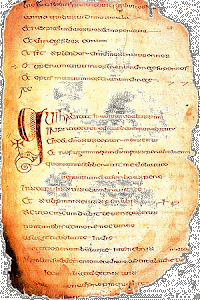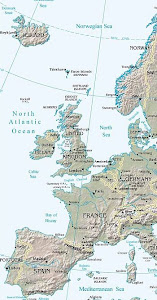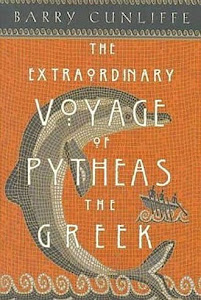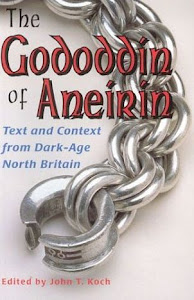The first screen epic is Bran Mak Morn, being made by British mini-major Working Title (Atonement, Elizabeth, Fargo, United 93), for 2010 release. Bran Mak Morn was a series of fantasy tales about the supposed last king of the Picts by ‘Conan’ creator, the 30s pulp author Robert E. Howard, a Texan self-conscious about his Celtic roots. The fansite rumour is that the chosen story will be “Worms Of The Earth” wherein let’s just say (I read it years ago) fearsome underground denizens are called up to rid the Pictish kingdom of the Romans.
As Howard’s work sprang from his fevered brow and has almost nothing to do with the actual Picts, there’s not much to say, except for their use of the idea the proto-Picts were a stunted underground race, surviving in hiding from the superior warrior race who invaded from Atlantis. This is one of several problems in the traditional depiction of the Picts – their identification with a dark dwarf-like ‘aboriginal’ race. This remains a source of irritation to anyone trying to give the historical Picts their due.
The second film project, now in post-production, is writer-director Neil Marshall’s Centurion, whose plot synopsis is given as follows:
AD 117. The Roman Empire stretches from Egypt to Spain, and East as far as the Black Sea. But in northern Britain, the relentless onslaught of conquest has ground to a halt in face of the guerrilla tactics of an elusive enemy: the savage and terrifying tribesmen known as the Picts. Marcus Dias, sole survivor of a Pictish raid on a Roman frontier fort, marches north with General Titus Virilus’ legendary 9th legion, under orders to wipe the Picts from the face of the earth and destroy their leader Gorlacon. But when the legion is ambushed on unfamiliar ground, and Virilus taken captive, Marcus faces a desperate struggle to keep his small platoon alive behind enemy lines, evading remorseless Pict pursuers over harsh terrain, as the band of soldiers race to rescue their General, and to reach the safety of the Roman frontier.
The IMDB tags it as a war-adventure drama/thriller, and it does sound like a plot setup familiar from WW2 dramas about the platoon or patrol cut off behind enemy lines trying to make their way back to their base. As the stoic title implies, the heroes are Romans, played by Michael Fassbender and Dominic West (of The Wire). Olga Kurylenko is Etain, which is at least a Celtic name, even if more Irish than Pictish. None of the other names in the IMDB list sound Pictish or even Celtic - Bothos, Macros, Thax, Gorlacon. The synopsis paints the Picts as ‘savage and terrifying tribesmen’ (“Cue the Pictish Hordes, and .. Action!”)
It sounds as if we’re in a similar treatment as in the 2004 film King Arthur with Clive Owen as a Roman Arthur (Artorius), venturing north of Hadrian’s Wall. There, the natives are called “Woads”, sort of angry peasants living in the bushes, who need Roman leadership to oppose the invading Saxons (who for reasons best known to themselves are here invading several centuries too early, and from the wrong end of the country). The script’s patronising designation of the natives as ‘Woads’ is no doubt is inspired by Caesar’s description of c54 BC how British men used the woad plant to paint their bodies blue all over. ("Omnes vero se Britanni vitro inficiunt, quod caeruleum efficit colorem, atque hoc horridiores sunt in pugna aspectu" - "In fact all the Britons dye themselves dark blue with woad, making themselves all the more terrifying in battle.")

(Hence Mel Gibson’s blue face [pictured] in Braveheart, which is completely ahistorical, but became a Scots nationalist rallying point – Scotland’s First Minister Alex Salmond said Braveheart had “given the Scots back their history”.)
The idea the Picts of succeeding centuries also painted themselves blue with woad seems to be a confusion with later Roman accounts of Pictish warriors tattooing themselves with blue marks, the woad being presumed to be the ink (though I’ve read of a modern investigation which found it to be useless, even dangerous, as tattoo ink). One account says they used iron to draw the shapes of animals on their faces and arms. Indeed, the name ‘Briton’ (as in Ancient Briton) has been parsed as People Of The Shapes or Designs. Anyone who thinks they were uncultured only needs to look at their artwork, which appears on so-called symbol stones. It’s almost a language of its own, and they symbolism remains obscure, just as the Pictish language, surviving only in written fragments such as memorial inscriptions, has never been deciphered.
The 3rd upcoming screen epic is the £15m production The Eagle Of The Ninth, an adaptation which we mentioned in a previous post, of a well-regarded 1954 young-adult novel by Rosemary Sutcliff OBE, CBE (1920-92), which begins filming this month, in Scotland and Hungary.
Though the IX Legion merely ceases to be mentioned by name in Roman imperial records, English writers have been trying to depict its ‘vanishing’ as British history’s equivalent of the 1876 Custer ‘Massacre’, with the Picts playing the role of those other painted savages, the Red Indians. (Novelist John Fowles’s reference to the Kelts as ‘the Red Indians of ancient Europe’ seems apt here.) No such battle is in fact known to history. (In fact, one 2007 film already had the IX legion as being not 'lost' but 'last': The Last Legion, starring Colin Firth and Ben Kingsley, has the characters trying to find the 9th, in 460 AD as the last one still loyal in Britain!)
The real Pictish confederacy, which probably arose as an anti-Roman alliance, was the foundation of a kingdom which eventually merged with their western neighbours the Scots, the kings being crowned at Scone using the Stone of Destiny as sacred relic. But even peaceful kings like Macbeth (now considered of Pictish descent) have been depicted as villains (even Shakespeare is guilty here).
 Until recent times (Dances With Wolves etc), Hollywood’s depictions of the North American native peoples have been crude, or worse. With film treatments of the natives of ancient Europe, we seem to be still in the stage where the natives are similar savages, always looking to make trouble for ‘civilised’ types (here the Romans and Romano-Britons). English historians quite shamelessly use the word barbarians to describe all those societies outside the Greco-Roman ‘classical’ civilisation (which was of course built on slavery), i.e. the native peoples of Europe.
Until recent times (Dances With Wolves etc), Hollywood’s depictions of the North American native peoples have been crude, or worse. With film treatments of the natives of ancient Europe, we seem to be still in the stage where the natives are similar savages, always looking to make trouble for ‘civilised’ types (here the Romans and Romano-Britons). English historians quite shamelessly use the word barbarians to describe all those societies outside the Greco-Roman ‘classical’ civilisation (which was of course built on slavery), i.e. the native peoples of Europe.The story setup here concerns “a wounded Roman soldier and his loyal Celtic slave who try to solve the mystery of the Ninth Legion, a brigade of Roman soldiers that vanished after heading into the untamed Highlands of Scotland 15 years earlier.”
The title refers to the fact the hero actually wants to recover the legion's lost eagle-motif standard. (If this sounds familiar, it's probably as an actual incident mentioned by Caesar in his Gallic Wars became the means whereby two 'plebian' characters were introduced into plotlines normally confined to imperial types for the BBC/HBO miniseries Rome - which may be returning to the screen.) The two young heroes (played by Hollywood’s Channing Tatum and ‘Billy Elliot’ star Jamie Bell) are a Roman citizen, Marcus Aquila, and his ‘Celtic’ freed-slave/sidekick, Esca, who Aquila rescued from a gladiatorial arena.
Hopefully, the depiction of the Picts will not be so backward - children’s literature and drama are carefully vetted for racial stereotyping etc. The talented and prolific Sutcliff, who was confined to a wheelchair for most of her life due to Still's Disease, was a dedicated historical novelist, whose work for children and young adults is largely still in print. The Eagle Of The Ninth (1954) was her first success, the start of a 6-book series, of which the two follow-ons are available together as a Puffin omnibus paperback [pictured].
It tells the story of a trek beyond the Roman Wall into the Pictish lands (up the W side of Loch Lomond towards Kintyre), where the duo must dwell among the Picts to obtain what they want by patience and guile. This type of story, classed as Captivity Narrative, is a venerable genre that has evolved from 17th-C shock-horror accounts of humiliations of Christians at the hand of benighted heathen savages, to a more enlightened approach where the two cultures are balanced out by having the ‘civilised’ one shown as repressive and unhealthy, as in Dances With Wolves.
But although there is also a tame wolf cub in this story, Sutcliff was still a product of her background and her era. That is, like other English historical novelists, she sympathised with the Roman invaders rather than the native British. In these works, the story of early Britain becomes the story of the Roman occupiers and their Romano-British successors. The Romans are always honourable and sensible, while the natives are ignorant and superstitious. (In the series followon Sword At Sunset, Arthur is a Roman-trained soldier who tells his story – the basis of the Arthurian legend - in the first person as a Roman military memoir.) Here, the legionary Eagle the heroes want to recover is predictably being guarded as a captive sacred icon (“the Red Crests God”), and they have to recover it to stop it being used to whip up anti-Roman hatred. (As if that would be necessary, with the Romans enslaving their families and sowing their fields with salt.) In a 1986 interview, Sutcliff admitted, “I think that I am happiest of all in Roman Britain. I feel very much at home there... The more level-headed viewpoint of the Romans is nearer to our own way of looking at things.” The story offers up as a guide a helpful blue-tattooed Pict, but he turns out to be an ex-Legionary survivor, now living among a southern Pict tribe.
The film’s Oscar-winning director discussed the project in a recent [3-Aug-09] article by Magnus Linklater in The Times, headlined as “Kevin Macdonald Will Bring To Film Pre-Celtic Clash Of The Cultures”. This raises the issue, an ongoing debate, as to whether the Picts are indeed pre-Celtic, even pre-Indo-European – hence their inscriptions remaining indecipherable. Here, the filmmakers are stuck with Sutcliff’s original story, and for reasons best known to herself Sutcliff has the Pictish Caledonian tribe called by the Romans the Epidii refer to itself as The Seal People. (Epidii is usually taken to be from the same root as the Celtic horse goddess Epona, pony - the Q-Celtic equivalent of what became equus in Latin - and would more likely mean Pony People.) Macdonald says the ‘natives’ will speak Gaelic (Pictish is a lost language – unlike the Lakota-Sioux speech in Dances With Wolves, it can’t be reconstructed). The Romans “will be played by American actors” to “achieve a little contemporary symbolism.” As to the mysterious Seal People, he says he has a theory who they might have been. “They were a more indigenous folk than the Celts, who were from further south. They were probably small and dark, like the Inouit, living off seals and dressed in sealskins. We are going to create a culture about which no one knows much, but which we will make as convincing as possible. We are basing it on clues gained from places like Skara Brae.”
The novel does refer to them as small and darker than most, but portraying the Epidii of Kintyre as remote Stone Age maritime seal-hunters like the Inuit seems to be more of the same stereotyped approach. It’s not a new theory, but rather a discredited 19th-C one that the Picts were small and dark as they were related to the Eskimos [Inuit], Basques, and Lapps [Sami people].
To use a cinema-going figure of speech, it sounds like where we came in.





